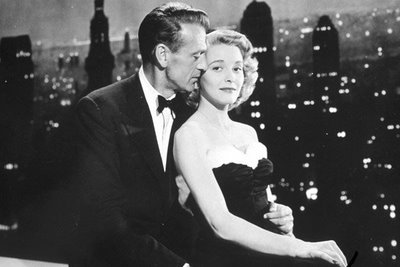« American Beauty (1999) – Movie Review | Home | Duets (2000) – Movie Review »
The Fountainhead (1949) – Movie Review
By Robert L. Jones | July 27, 1999

Patricia Neal found that Gary Cooper's acting wasn't his only wooden attribute
Of Underdogs and Übermensch
[xrr rating=4/5]
The Fountainhead. Starring Gary Cooper, Patricia Neal, Raymond Massey, Kent Smith, Robert Douglas, Henry Hull, Ray Collins, Moroni Olsen, and Jerome Cowan. Cinematography by Robert Burks, A.S.C. Edited by David Weisbart, A.C.E. Music by Max Steiner. Screenplay by Ayn Rand, based on her novel. Directed by King Vidor. (Warner Bros. Pictures, 1949, Black and white, 114 minutes. MPAA Rating: Not Rated.)
Because David O. Selznick (producer of Gone With the Wind and Rebecca) didn’t produce this as a faithful adaptation of Ayn Rand’s novel, but Henry Blanke (The Maltese Falcon and Casablanca) did, I recommend seeing the movie before reading the novel. The problem of properly sequencing these events is one familiar to too many of fans of Ayn Rand’s novel about Howard Roark, an architect of uncompromising integrity: When you read the novel first, you cast it, design its sets, and play it out in your mind. And in my mind, Howard Roark is played by Burt Lancaster, Ingrid Bergman is ice queen (who melts at Roark’s touch) Dominique Francon, Farley Granger as Peter Keating, and Orson Welles plays a thinly-veiled Charles Foster Kane, a.k.a. Gail Wynand. (I would keep Robert Douglas as Ellsworth Toohey, he is so perfectly cast). Screenplay by Leigh Brackett and Ben Hecht, directed by Howard Hawks, Technicolor, music by Bernard Herrmann.
Anyways, since that’s all in my mind’s eye, let us deal with what’s actually there:
Without giving away the plot too much, the story deals with one of novelist Ayn Rand’s most crucial themes: The individual versus the collective.
Her loner individualist is architect Howard Roark (Gary Cooper), loosely based on the seminal real-life modernist Frank Lloyd Wright. Through Roark, Rand demonstrates the injustices that come hand-in-hand with being a misunderstood genius. That is, at least, by society’s drab masses. Manipulating them is rabble-rousing columnist Ellsworth Toohey (Douglas), a fastidious, fascistic little man who understands Roark’s genius all-too well–and thus wants him destroyed. Toohey also has evil designs on press baron Gail Wynand (Raymond Massey), who runs his media empire by controlling public opinion on a macro scale. Yet, Wynand learns only too late that the devil’s in the details.
As a work of cinema, The Fountainhead is one of the greatest examples of post-German expressionism after World War II. Visually, it’s overflowing with Licht und Schatten worthy of Fritz Lang and F.W. Murnau. This is the movie’s greatest achievement, deftly accomplished by cinematographer Robert Burks, who confines martyred saint Cooper in a shadow-world so oppressing, that it rivals Martin Scorsese’s Taxi Driver and Alfred Hitchcock’s I Confess (the latter for which Burks was also director of photography, as he was on all Hitch’s films from the early 1950s through Marnie, in 1964, with the exception of Psycho) for the sense of loneliness and psychological isolation which crowd in the hero.
Burks owes a lot to Citizen Kane in the use of low-camera-angles employed in projecting the movie’s tragic hero, Gail Wynand. Actor Massey brings a British-Canadian flair to the role that is completely outrageous and totally incongruous with the its Hell’s Kitchen origins. So what! As with Cary Grant, Massey succeeds in the “willing-suspension-of-disbelief” department when it comes to ignoring his British accent.
Burks’s camera lingers longingly and tenderly on screen siren Patricia Neal, as Dominique. This is when real hot women with ample bosoms got Hollywood roles, and when the likes of Marilyn Monroe “replaced” Jane Russell and Kim Novak was groomed as the next Rita Hayworth. The scene in which Neal visits Coop’s apartment with the none-too-subtle white fur bust ornament topping her evening gown is priceless in the glamour department. Some of today’s critics call this movie “dated.” If by “dated,” they mean not having untalented, unalluring, and underfed matchsticks such as Gwyneth Paltrow and Calista Flockheart, then, yes, The Fountainhead is “dated.”
Englishman Robert Douglas plays Toohey, the demagogic columnist with searing intelligence and over-the-top, villainous aplomb. Wielding his ever-present cigarette holder with blatant swishiness designed to circumvent the Hayes’ office censors, Douglas gives the best flamboyant homosexual villain performance this side of Robert Walker, as the tortured Bruno in Hitchcock’s Strangers on a Train.
Rounding out this bombastic Expressionist tour-de-force is Max Steiner’s equally plush and bombastic Romantic score, which uses heavy brass and low strings to provide an aural sledgehammer that sets the action onscreen to the passionate Sturm und Drang of Tristan und Isolde. They don’t make movie music like that anymore. Composer David Raksin (Laura) once quipped that 1940s movie music overwhelmed the listener not only with foreboding, but with “fifthboding.”
Again, compare Steiner’s “maximalism” (pun intended) with the oat-bran sparseness of today’s so-called composers, such as Philip Glass (“minimalist” is too big a word to describe his simplistic, monotonous, scratchings) and Michael Nyman.
The Fountainhead is a movie made about giants, by giants. Reality be damned, this pic is worthy of Citizen Kane, Metropolis, and The Big Sleep.
Now, once you’ve seen the movie, then read the book, which is even better! Do it the other way around, and you’ll find yourself “what-if’ing” The Fountainhead that could’ve been, rather than basking in this sterling example of 1940s cinema.
Robert L. Jones is a photojournalist living and working in Minnesota. His work has appeared in Black & White Magazine, Entrepreneur, Hoy! New York, the New York Post, RCA Victor (Japan), Scene in San Antonio, Spirit Magazine (Canada), Top Producer, and the Trenton Times. Mr. Jones is a past entertainment editor of The New Individualist.
Topics: Classic Movies, Courtroom Dramas, Dramas, Movie Reviews | Comments Off on The Fountainhead (1949) – Movie Review
